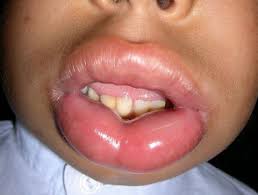 Hereditary angioedema(HAE) is a rare disorder caused by deficiecny of C1 –inhibitor(C1- INH) since birth.
Hereditary angioedema(HAE) is a rare disorder caused by deficiecny of C1 –inhibitor(C1- INH) since birth.
There are two types of HAE,TYPE 1 and TYPE 2
In type 1 HAE ,there is hereditary deficiency of C1- INH ,whereas in type 2,the level of C1- INH in serum may be normal or elevated but the C 1-INH function is impaired.
C 1- INH interact with approximately 60 other proteins in the body to protect the body from infections.
In its absence,there is failure of degradation of bradykinin, the level of which rises in blood.
Bradykinin,increases the permeability of blood vessels by causing inflammation and dilatation of the vessels.
In effect,the intravascular fluids leak from the blood vessels and accumulate between layers of skin and epithelium.
There occurs swelling all over the body including tongue and lips causing disfigurement.
When the swelling occurs in the respiratory airways ,particularly involving larynx,it may be life threatening,unless treated on emergency basis.
These swellings,usually do not respond to antihistamine,adrenaline,and corticosteroids.
The specific treatment is Berinert , HAEGARDA , or Bradykinin receptor antagonist FIRAZYR(ICATIBANT)which is difficult to get in resource poor countries including India.
There is one case report from Pakistan,a 30 year patient was admitted in emergency after a fall. In the hospital,it was found from the medical record that the patient was a known case of HAE.
The patient got swelling including laryngeal edema which did not respond to antihisamine,adrenaline and corticosterois.The patient developed respiratory distress and went into pulseless cardiac arrest ,revived after CPR and had to be intubated.
Treating doctors decided to give FFP, in view of non availability of specific treatment of HAE.
FFP(Fresh frozen plasma) was given 6 hourly and the patient responded after 18 hours,extubated after 3 days and stepped down from ICU to the ward.He was discharged on danazol prophylaxis and did well on follow up.
There was no adverse effect noted due to FFP.
This is first case report ,published in CUREUS.
FFP contains so many substances apart from C1-INH,which may cause harm to an individual.
If more ,multcentric studies prove its efficacy and safety profile ,,it will be a boon to the patients in resource poor countries.
REFERENCES;OCTOBER 12,2020,In News,By FOREST RAY
Forest Ray received his PhD in systems biology from Columbia University, where he developed tools to match drug side effects to other diseases. He has since worked as a journalist and science writer, covering topics from rare diseases to the intersection between environmental science and social justice. He currently lives in Long Beach, California.
Fact Checked By:
Ines Martins, PhD
Inês holds a PhD in Biomedical Sciences from the University of Lisbon, Portugal, where she specialized in blood vessel biology, blood stem cells, and cancer. Before that, she studied Cell and Molecular Biology at Universidade Nova de Lisboa and worked as a research fellow at Faculdade de Ciências e Tecnologias and Instituto Gulbenkian de Ciência. Inês currently works as a Managing Science Editor, striving to deliver the latest scientific advances to patient communities in a clear and accurate manner.
 Sleep is very important state of health.
Sleep is very important state of health. Hereditary angioedema(HAE) is a rare disorder caused by deficiecny of C1 –inhibitor(C1- INH) since birth.
Hereditary angioedema(HAE) is a rare disorder caused by deficiecny of C1 –inhibitor(C1- INH) since birth.